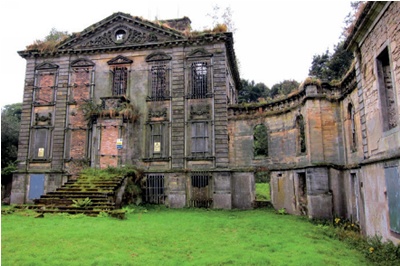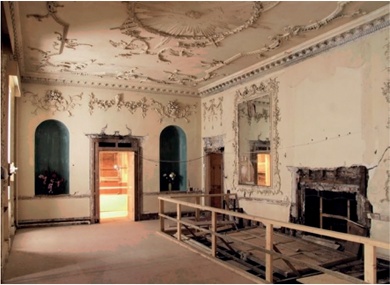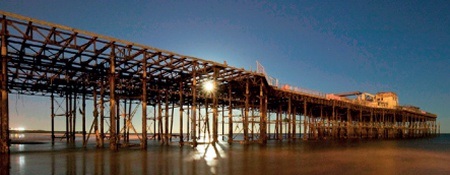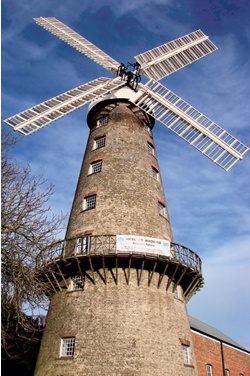Buildings at Risk
Ian Lush
 |
||
| Mavisbank House, a long-derelict villa near Edinburgh, which is the subject of a planned restoration project coordinated by the Mavisbank Trust (All photos: AHF) |
It is safe to say that anyone working, volunteering or simply interested in the UK’s historic environment would agree that a historic building at risk is a ‘bad thing’. But what exactly is a building at risk, how many are there, how do they become at risk in the first place and, most importantly, what is being done about it?
The definition of a building at risk varies, but usually involves inclusion on an official list or register. This could be compiled by a national body such as English Heritage or Cadw in Wales, by a local authority, or by a specialist third sector organisation like The Theatres Trust or SAVE Britain’s Heritage. Buildings are added to these registers because of concerns about their physical condition, neglect by their owners and/or lack of an economically viable use. The proliferation of registers and the fact that in most of England only buildings listed at Grade I and Grade II* are currently included on the registers means that estimating the total number of historic buildings at risk in the UK is difficult. However, we do know the following:
In 2012 there were 5,831 entries on the English Heritage Heritage at Risk Register in England, which includes Grade I and II* buildings (plus Grade II in London), monuments, archaeological sites, landscapes, battlefields, protected wrecks, places of worship and conservation areas. Current figures for Scotland, where the register is maintained by the Royal Commission on the Ancient and Historical Monuments of Scotland on behalf of Historic Scotland, show that there are 2,504 historic buildings at risk. The latest figures in Wales estimate c3,000 listed buildings to be at risk, around ten per cent of the total. In Northern Ireland there are over 420 listed buildings on the Built Heritage At Risk Northern Ireland database, which is maintained for the NI Environment Agency by the Ulster Architectural Heritage Society.
Conscious of the fact that coverage of Grade II buildings at risk in England on local authority registers is, to say the least, patchy, English Heritage has been considering ways to address the gaps. Recently it commissioned 19 pilot studies where volunteers surveyed Grade II buildings in different local authority areas (rural and urban) to identify those which are, or potentially may be, at risk. At the time of writing, the results have not been announced but early indications are that the position in some of the areas surveyed was not as bad as had been anticipated in numerical terms, although some of the problems identified were clearly serious ones.
This brings us on to the other questions – the circumstances that lead to buildings becoming at risk, and what is happening to them. One of the most repeated truisms in the heritage sector is that there is no such thing as a problem building, just problem owners. This is certainly the case for many at risk buildings, but by no means all, and the issues tend to be complex. Neglect, however, whether deliberate or not, is undoubtedly one of the main causes and it is remarkable, and very sad, how quickly a building’s state can deteriorate once basic maintenance is abandoned and a structure is no longer protected from the elements.
 |
|
| Poltimore House, near Exeter: despite setbacks including the discovery of asbestos, efforts continue to save this extraordinary Grade II* building. |
There are many reasons why an owner might neglect a building. In some cases this will be deliberate – a developer has bought the building for the value of the site rather than the structure, has perhaps been turned down for planning permission to demolish and is allowing its condition to deteriorate in the hope that permission may eventually be granted.
The statutory planning authorities have a range of tools available to them to tackle this situation, from urgent works notices right up to compulsory purchase orders, and some use them effectively and speedily. Other authorities are daunted by the relative complexity and potential cost of using the legislation, or simply do not have staff with the necessary knowledge and experience.
More recently, the recession and commensurate decline in property values, particularly outside London and South East England, has left some private or commercial owners with buildings worth far less than they paid for them at the height of the boom years, struggling with maintenance costs and lacking an exit strategy.
In some cases these are buildings bought at auction without the purchaser even having visited, never mind having commissioned a survey or valuation, in which case you may feel that their greed is now reaping its just reward. In other cases, however, historic buildings were bought in good faith by private individuals who genuinely hoped to restore or repair them and either live in them or sell them. Those individuals now find themselves out of their depth, with mortgage debt exceeding the property’s value and already considerably out of pocket. In some cases ownership of a building at risk is convoluted and the owner is difficult to trace. Even if the owner is tracked down, he or she may be reluctant to enter into a dialogue. Hastings Pier, for example, was until recently owned by a company registered in Panama, and only the determined effort of local people over many years persuaded Hastings Borough Council, and ultimately the government, to compulsorily purchase it for a community-led trust to own and manage, following a major restoration scheme which is being funded by the Heritage Lottery Fund, the Architectural Heritage Fund and many others.
A further, and growing, category of historic buildings at risk is made up of those where the use has been deemed redundant by the owner, often a public body. This might be a Carnegie library which the local authority has decided to close and replace with a brand new glass and steel ‘knowledge hub’, with banks of PCs and not many books. Or it could be a fire station, Victorian school, town hall or swimming baths where the cost of modernisation and adaptation is seen as prohibitive. In the ideal scenario the public body that owns the building has thought through the ramifications of its decision to close it and has an asset disposal strategy in place, involving consultation with the local community and even giving options to community and voluntary sector groups to take on the building for their own uses under the asset transfer legislation. Sadly this is not always the case and some public buildings are simply abandoned while others are sold on the open market, often to be turned into expensive flats – far from the civic purpose for which they were originally intended.
 |
| Hastings Pier following a devastating fire in October 2010 |
The Architectural Heritage Fund (AHF) sees many cases where people come together specifically because of concerns about a prominent at risk building in their local area. The AHF then suggests who else they should talk to, always starting with the local authority which, as outlined above, has the powers to try to deal with owners and can advise on planning issues.
The AHF’s other principal concerns, even at this early stage, are whether an economically viable use is likely to be identified for the building and how the capital works may be funded. AHF grant funding is geared towards helping groups to ascertain the answers to these vital questions, initially through a short study called a viability assessment. This should look at the building’s structural issues, its current and potential value, ownership and the willingness or otherwise of the owner to negotiate on a disposal, and, perhaps most importantly, the potential use and long-term sustainability.
Of course the AHF is by no means the only funding body that can help community groups and others tackling historic buildings at risk. The Funds for Historic Buildings website is a free database listing all the major funding sources and can be searched according to building type, location and ownership, including private ownership. Financial help for private individuals, however, is scarce because most charitable trusts will only fund other charities or not-for-profit organisations.
The Heritage Lottery Fund (HLF) is by far the largest supporter of projects tackling buildings at risk, and in April 2013 it launched the Heritage Enterprise scheme, specifically aimed at encouraging communities to work with developers to find commercially viable solutions for large at risk buildings. At the same time the HLF also introduced start-up grants of up to £10,000 intended to help new groups at the outset of their projects.
The Joint Committee of the National Amenity Societies, which brings together the likes of the Ancient Monuments Society, the Victorian Society and the Twentieth Century Society, runs another valuable website, Heritage Help (see further information). This contains short articles on some key issues for owners of listed buildings, campaigners and community groups and also acts as a gateway, signposting users to the main sources of information on topics such as planning, maintenance and funding. Buildingconservation.com also provides an extensive list of free articles including many on funding, legislation and the work of the major heritage amenity societies.
 |
|
| Moulton Windmill, Lincolnshire: the nine-storey mill opened to the public in 2005 following a restoration programme led by the Moulton Windmill Project, a collaboration between local volunteers and the Lincolnshire Mills Group. |
So there is plenty of information and advice available, but what is the picture like when it comes to trying to tackle all those buildings at risk on the various lists and registers? First of all, it is worth remembering that many are not ‘buildings’, as such, but would be more accurately deemed ‘structures’. These might, for example, include gateposts, walls, fountains, monuments and consolidated ruins – none of them capable of what the AHF would term ‘beneficial reuse’. It is often challenging to persuade an owner to invest in the maintenance of such structures and hence they tend to fall into disrepair and become at risk.
There are also buildings which have been on these registers since they were first compiled. These are the ones where the problems are seemingly so intractable that a solution seems virtually impossible. However, in time and with the right momentum behind them, the seemingly impossible can become the next major heritage project. Hastings Pier, particularly after a disastrous fire in 2010, looked as if it might be consigned to a similar fate to Brighton’s West Pier, but the determination of a local trust has ensured a potentially happy ending to this particular heritage story. Two other heritage causes célèbres, Mavisbank House outside Edinburgh, and Wentworth Woodhouse in South Yorkshire, are now the subject of renewed schemes for restoration and reuse, having also been written off by many over the years.
Ten years on, it is quite encouraging to look back at those buildings, including Mavisbank, which featured in the first series of the BBC’s Restoration in the late summer of 2003. Of the 30 buildings included in the series, many have been fully or partially restored, having undoubtedly benefitted from the high profile such coverage brings. Moulton Windmill in Lincolnshire is one such, now with its sails refitted and opening to the public on a regular basis. Lissan House in Northern Ireland, the runner-up to Manchester’s Victoria Baths, is also thriving, repaired and in use for a wide variety of events and activities. Considerable progress has also been made by the likes of Cromford Mills in Derbyshire, Llanelly House in Wales and Arnos Vale Cemetery in Bristol.
Others, however, tell a less palatable story, and one which perhaps sums up the challenges facing buildings at risk in the UK in the 21st century. Glen O’Dee Hospital in Scotland, despite the efforts of a consortium of third sector bodies, was sold by the NHS to a developer and it lies abandoned and derelict, with some of the historic structure already demolished. At the other end of the British Isles, the Poltimore House Trust in Exeter has had to overcome the unexpected discovery of asbestos, further deterioration of the main house and a number of funding setbacks and yet, with the support of the AHF and others, the trust continues its valiant efforts to save this extraordinary building.
A similar story can be told in almost every community in the UK – local people working together to try to save a much-loved historic building. We are seeing more cases where groups are taking advantage of the asset transfer and community rights legislation from the Localism Act 2011, to stop significant buildings being sold for private development and instead retain them for community use. The campaigners trying to keep the Ivy House in Nunhead, South London as a pub, were the first successfully to use the legislation, and, with the help of funding from the AHF and the Social Investment Business, bought the building using the Community Right to Bid provision. The building re-opened in August 2013 as a thriving community-owned business.
This may well be the shape of future projects to rescue buildings at risk – where the emphasis is on the use of the building rather than its heritage and historic importance. Whichever approach is taken, what is certain is that community groups, third sector organisations, private and commercial owners, local authorities and the government in all four home nations need to work together to find imaginative and sustainable solutions for these buildings at the heart of our communities, so that in years to come the numbers on those risk registers start to come down significantly.
Further Information
The Architectural Heritage Fund www.ahfund.org.uk
Funds for Historic Buildings www.ffhb.org.uk
Heritage Help www.heritagehelp.org.uk
The Heritage Lottery Fund www.hlf.org.uk



